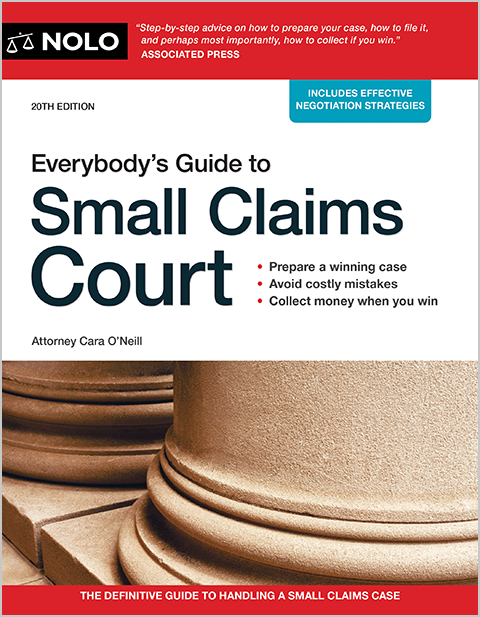Here's what you need to know about how time limits can affect your legal claims.
For example, one state might allow a plaintiff with a personal injury claim one year from the date of injury to file suit, and a plaintiff with a breach of contract claim four years from the date of breach to sue. In another state, plaintiffs could have two years for personal injury cases, and five years for breach of contract claims.
Learn more about the statutes of limitation in your state. If you have questions about time limits on lawsuits, talk to a lawyer. The rules can be complex and the consequences for failing to follow them are harsh—you'll lose the right to pursue your action.
- When Does the Clock Start Ticking for Statutes of Limitations?
- Are Statutes of Limitations for Suing Someone Always One Year?
- I'm Defending Myself in a Lawsuit for Something That Happened Years Ago. Will the Judge Automatically Throw the Case Out?
- What Are the Statutes of Limitations for Suing Government Agencies?
- What Are the Statutes of Limitations in California?
- Talk to a Lawyer
When Does the Clock Start Ticking for Statutes of Limitations?
Once you've figured out which statute of limitations applies to your case, your next step is to determine when the clock starts ticking. Usually, the time begins to run on the "date of harm"—that is, on the date when you were injured, your property was harmed, or a contract or agreement was violated.
However, another part of this general rule exists. It protects plaintiffs during the time when they aren't aware that they've been harmed—which could be for months or even years. In such cases, the statute of limitation clock starts ticking either on the "date of discovery" of the harm or on the date on which the plaintiff "should have discovered" the harm. In short, for some types of claims, the statute of limitations clock can start ticking at three different times:
- Earliest: The date of harm.
- Later: The date on which the plaintiff reasonably should have discovered the harm. This refers to the date when a judge considers it fair to say that the plaintiff should have known about the harm, even if the plaintiff didn't actually know about it.
- Latest: The date on which the plaintiff actually discovered the harm.
Let's take a look at a few examples of how these rules might apply to a medical malpractice claim.
Example 1
On January 1, a doctor performs a gallbladder operation on Phoebe but mistakenly removes Phoebe's spleen. The doctor tells Phoebe of the surgical error as soon as she wakes up. Phoebe's time period for suing the doctor begins to run on January 1, since the harm occurred on that date and Phoebe actually knew about it. If a two-year statute of limitations for medical malpractice applies to Phoebe's case, she'd have two years from January 1 to file a lawsuit against the doctor.
Example 2
The facts above apply except the doctor doesn't tell Phoebe about the surgical screwup. Phoebe is in constant pain following the January 1 surgery. A month later, on February 1, Phoebe talks to another doctor who tells her that she should not be in pain and that she should immediately come in to have it checked out. Phoebe delays going to the doctor until July 1 of the same year, at which time she finds out that her spleen had been removed mistakenly on January 1. In this situation, Phoebe's time period for suing the doctor probably begins to run on February 1, because the pain coupled with the second doctor's advice determines when Phoebe reasonably should have discovered the harm.
Example 3
Same case, except that Phoebe suffers no unusual after-effects following the January 1 surgery. Phoebe is unaware that anything went wrong with the surgery until July 1 of the same year, when an X-ray during a routine medical checkup reveals that her spleen was removed. In this situation, since Phoebe did not discover and could not reasonably have discovered the harm until July 1, most states would measure Phoebe's time to sue from July 1.
Are Statutes of Limitations for Suing Someone Always One Year?
No, but statutes of limitations generally allow at least one year. Except for when you sue a government agency, you almost always have at least one year from the date of harm to file a lawsuit, no matter which type of claim you have or which state you live in. In short, you should have no statute of limitations worries if you sue within this one-year period.
Let's say Henry is injured in an auto accident on February 1. On March 1 of the same year, Henry talks to a lawyer. The lawyer tells Henry to try to get compensation for his injuries from the at-fault driver. Henry spends months trying to settle with the at-fault driver's insurance company. Finally, on September 1 of the same year, the insurance company writes to Henry to say, "We'll pay you $1,000, nothing more." Henry concludes that the offer is grossly inadequate and decides to sue the other driver. If Henry isn't sure of his state's statute of limitations for personal injury cases, he should be sure to file the suit before February 1 of the next year and his complaint will be timely.
An experienced lawyer should be able to explain the ins and outs of the timing issues involved in your case.
I'm Defending Myself in a Lawsuit for Something That Happened Years Ago. Will the Judge Automatically Throw the Case Out?
No, judges rarely throw out late claims on their own. Defendants must bring a statute of limitations violation to the court's attention.
To be sure that a judge dismisses an untimely case, you include an "affirmative defense" in your answer, alleging that the plaintiff's complaint is untimely. As an alternative to filing an answer, in some courts you can file a Motion to Dismiss, asking a judge to throw out an untimely complaint.
If you are a defendant who thinks that the plaintiff may have waited too long to sue, you'll need to check the applicable state or federal limitations period to determine whether the lawsuit is timely. (You might want to speak to an experienced lawyer, who should be able to explain this complicated area of law.)
What Are the Statutes of Limitations for Suing Government Agencies?
You typically can't sue a government agency unless you first file an administrative claim with the city, county, or state of which the agency is a part. And you may have as little as 60 days to submit an administrative claim. If (as usually happens) the government denies your claim, the denial letter will tell you how long you have to file a lawsuit in court. Check your state's rules quickly after you suffer harm, and consider talking to an attorney for a full explanation of the relevant time periods.
What Are the Statutes of Limitations in California?
Below you'll find California's statutes of limitations for several common types of lawsuits. These are just broad overviews. Be aware that the law changes and that the rules can be more complex than indicated here. An experienced lawyer should be able to explain the relevant law as it applies to your situation.
- Medical malpractice actions: Three years from the date of injury or one year from the date the plaintiff discovered or should have discovered the injury, whichever occurs first. (Cal. Civ. Proc. Code § 340.5 (2023).)
- Breach of an oral contract: Two years. (Cal. Civ. Proc. Code § 339 (2023).)
- Breach of a written contract: Four years. (Cal. Civ. Proc. Code § 337 (2023).)
- Suits for libel or slander: One year. (Cal. Civ. Proc. Code § 340 (2023).)
- Personal injury claims based on negligence: Two years. (Cal. Civ. Proc. Code § 335.1 (2023.).)
- Childhood sexual assault:
- 22 years from the victim's 18th birthday (in other words, by the time the victim turns 40), or
- five years after the victim discovers or should have discovered that psychological injury or illness occurring after age 18 was caused by the sexual assault (whichever is later). (Cal. Civ. Proc. Code § 340.1 (2023).)
- Suits for injuries resulting from domestic violence:
- three years from the last act of domestic violence, or
- three years from the date the victim discovered or should have discovered that an injury or illness resulted from domestic violence (whichever is later). (Cal. Civ. Code §§ 1708.6 (2020); Cal. Civ. Proc. Code § 340.15 (2023).)
Talk to a Lawyer
Calculating the statute of limitations can be tricky and the consequences for making a mistake are harsh. If you miss the filing deadline, a judge will likely have no choice but to dismiss your lawsuit and you'll lose your chance to get compensation for your injuries and losses.
If you have questions, talk to a lawyer. Learn more about working with a lawyer. When you're ready, you can connect with a lawyer directly from this page for free.
- When Does the Clock Start Ticking for Statutes of Limitations?
- Are Statutes of Limitations for Suing Someone Always One Year?
- I'm Defending Myself in a Lawsuit for Something That Happened Years Ago. Will the Judge Automatically Throw the Case Out?
- What Are the Statutes of Limitations for Suing Government Agencies?
- What Are the Statutes of Limitations in California?
- Talk to a Lawyer



